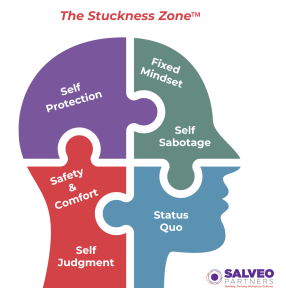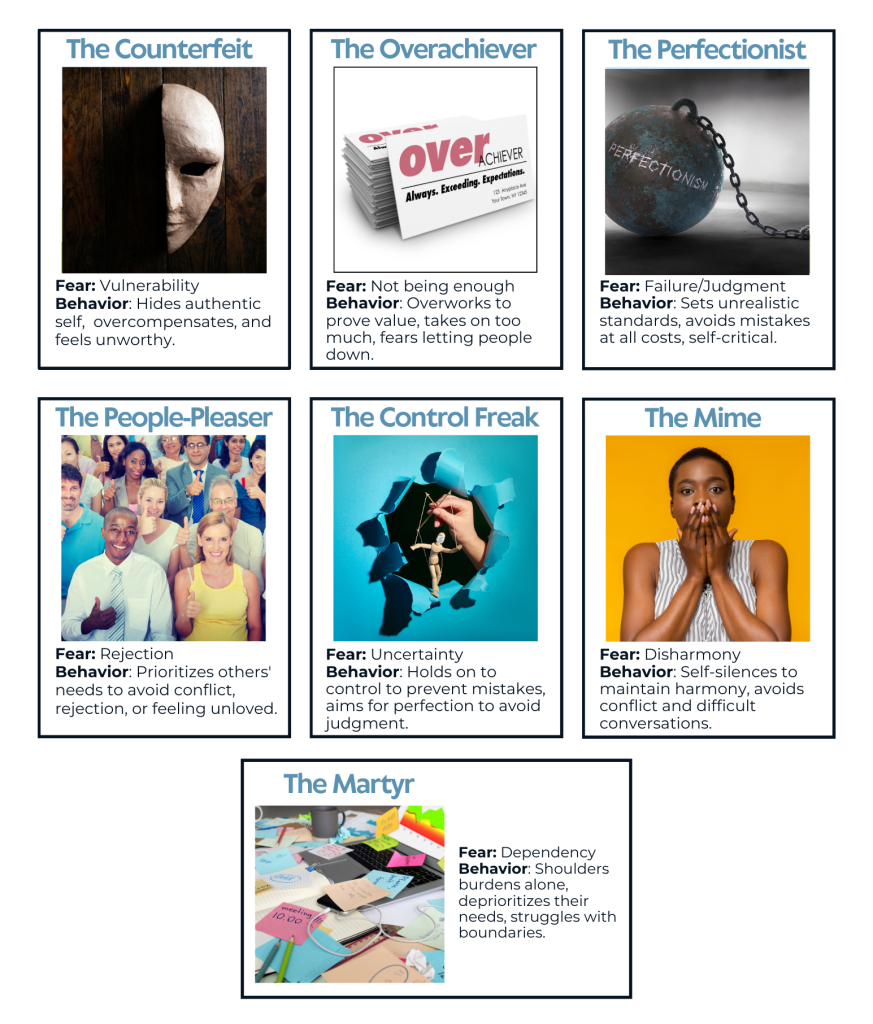Organizations today face an environment defined by constant disruption. Advances in technology, shifting workforce expectations, economic uncertainty, and global crises have created a workplace where volatility is the norm. Yet despite adapting strategies and investing heavily in development programs, many leaders describe feeling overwhelmed, exhausted, or stuck.
Why?
Our research at Salveo Partners uncovered a hidden barrier that undermines even the most capable leaders. We call it the Stuckness Zone™—and it’s fueled by what we’ve identified as Faulty Programs. These are unconscious patterns that quietly sabotage effectiveness, block innovation, and keep leaders from showing up as their best selves.
The Stuckness Zone: Where Biology Meets Complexity
 At its core, the Stuckness Zone represents the widening gap between what today’s world demands and our biological
At its core, the Stuckness Zone represents the widening gap between what today’s world demands and our biological
wiring to self-protect.
Our brain can’t distinguish between a physical threat (like being chased by a predator) and a social threat (like receiving critical feedback in a meeting or being judged by others). Both threats activate the same automatic fight-flight-freeze response. Neuroscientist Dr. David Rock refers to these reward and threat centers in our brain in his SCARF model: status, certainty, autonomy, relatedness, and fairness. When any of these elements are threatened, we experience the “amygdala hijack” and automatically go into self-protective mode. At the same time, when we nurture each element, we experience a reward response.
The problem is that modern workplaces are full of social threats that activate SCARF in our brains. A missed deadline, a tense team conflict, or a high-stakes presentation can all trigger self-protection. Consequently, leaders often double down on familiar behaviors—such as controlling, overachieving, and people-pleasing—that may feel safe but actually drain energy and erode trust.
Senior partners at McKinsey & Company describe this as the “adaptability paradox”; “at the very moment when we most need to break free from our habitual patterns, we are unable to do so.” To move beyond the Stuckness Zone and its paradox, we must develop braver leaders and cultivate more courageous cultures.
Want to dig deeper? Download our free research paper, Future-Proofing Leadership: What It Takes to Thrive Amidst Change and Disruption, to explore the findings from our study of 250 leaders across industries.
What Are Faulty Programs?
Faulty Programs are the outdated mental scripts and beliefs that run in the background and form our inner operating system that guides our actions. They are formed early in life—during what researchers call the imprint period—when we subconsciously absorb messages about what earns us acceptance, safety, and love.
These programs helped us navigate the world in those early years, and, whether we realize it or want to admit it, they are predominantly in the driver’s seat today, not our adult self. When these outdated programs are running the show, they can sabotage our ability to thrive in complexity. Studies estimate that 95% of our brain activity runs on autopilot and that up to 70% of this programming is flawed, negative, and self-sabotaging. That means much of our behavior is guided by beliefs we didn’t consciously choose, many of which no longer serve us. We’re essentially letting our own head trash guide us through a world that needs more complex thinking.
Harvard psychologists Robert Kegan and Lisa Lahey describe this phenomenon as our psychological immune system—an unconscious set of protections that shields us from fear of judgment, rejection, or failure. But just like what happens when someone has an autoimmune disorder (where the body starts attacking itself), this system can backfire. Instead of protecting us, it works against us, preventing our ability to experiment, grow, and make the changes our organizations need.
Think of it like having one foot on the gas—you’re motivated to grow, lead, and innovate—while the other foot is unconsciously pressing the brake, trying to keep you safe so your worries and fears (and perceived social threats) don’t come to light. The result? Frustration, burnout, and stalled progress.
The Seven Faulty Programs Leaders Run
Through detailed analysis of 250 leaders across industries (85 in-depth interviews and 165 coaching data sets), we identified seven core Faulty Programs and three “cousins” that derail leaders.
Here are the seven core programs:

- Counterfeit – Hiding parts of your authentic self out of fear of not being enough.
- Overachiever – Believing your worth is tied to constant doing, productivity, and proving.
- Perfectionist – Fearing failure so deeply that only flawless performance feels safe.
- People-Pleaser – Avoiding rejection and prioritizing approval over your true needs and voice.
- Control Freak – Clinging to certainty, micromanaging, or overpreparing to feel safe.
- Mime – Self-silencing to maintain peace and harmony, even when your perspective is needed.
- Martyr – Maintaining self-sufficiency and not relying on others while neglecting yourself, often leading to resentment.
The three cousin programs—Dropout (fear of looking stupid or incompetent), Fraud (fear of being found as an imposter), and Protector (holding yourself responsible for others’ experiences and outcomes)—don’t stand alone; they always show up in tandem with the core programs, intensifying their effects.
We also learned that most leaders aren’t running just one faulty program. They’re juggling several, creating a tangled web of self-protection strategies that consume enormous mental energy.
The Human and Organizational Costs
When Faulty Programs are in the driver’s seat, the costs are profound.
- For individuals: Faulty Programs drive chronic stress, erode confidence, and contribute to the epidemic of burnout. Leaders hijacked by these programs often describe questioning their value or overcompensating in unhelpful ways to prove themselves and outrun feelings and fears of being less than.
- For organizations: Faulty Programs create cultures of defensiveness rather than trust. McKinsey reports that 75% of senior leaders say their leadership development models aren’t delivering value. Why? They often focus on skills and behaviors while ignoring the inner programming that drives them.
Josh Bersin has put it bluntly: “Companies have been neglecting their leadership, and it shows.” Leadership failures don’t stem from a lack of technical knowledge—they stem from outdated, fear-driven mindsets.
Why We Get in Our Own Way
Faulty Programs explain why leaders so often sabotage the very goals they care about most.
- A leader striving to improve communication may also be running the Mime or People-Pleaser programs, which can hold them back from having difficult conversations.
- Someone working on better delegation may be driven by Martyr or Overachiever tendencies, making it nearly impossible to let go.
- Leaders wanting to be more innovative may default to Control Freak or Perfectionist programming, resisting risk in the name of safety.
Our data showed that nearly all leaders have goals that fall into adaptive change territory—meaning a simple technical fix can’t solve them. These goals require transformation at the mindset level. Without addressing the underlying Faulty Programs quietly working against them, even the best tools and training won’t stick.
Breaking Free: The Upgrade Process
The good news? Faulty Programs are not destiny. They can be upgraded.
As with anything related to our development, the path begins with awareness—identifying the programs that are hijacking your leadership. From there, leaders can:
- Name it. When your Faulty Programs take over, call them by name; this helps separate you from the programming.
- Own it. Reflect on the origin of your Faulty Programs that led you to believe the lies they tell you. Take ownership of what head trash they create by using the phrase, “The story I’m telling myself is…” This creates space to fact-check limiting beliefs instead of treating them as truth. Also, own how you behave when these Faulty Programs are running the show.
- Challenge it. First, start replacing the head trash with something that is more empowering and serves you and others better. Second, visualize what life would be like in terms of how you would think, feel, and behave differently if your Faulty Programs were no longer in the driver’s seat. Finally, start challenging their validity by running mini experiments to collect counter-evidence that disproves them. For instance, notice times when imperfection didn’t ruin trust or when saying “no” or speaking up actually strengthened a relationship or process.
Make no mistake, the upgrade process takes time and courage; it will be an ongoing journey. However, once you complete the messy work of the initial upgrade, subsequent upgrades will be much quicker. As Ronald Heifetz and Marty Linsky remind us: “Without learning new ways—changing attitudes, values and behaviors—people cannot make the adaptive leap necessary to thrive in the new environment.”
This is not about fixing broken leaders. It’s about reclaiming the energy lost to self-protection and channeling it into trust, adaptability, and human connection.
A good first step: Our Courageous Leadership Program helps leaders identify their Faulty Programs and begin the upgrade process in a supportive, transformational way.
What’s Next in This Series
This blog is the first in a series unpacking the Faulty Programs. Over the coming weeks, we’ll dive deep into each one, starting with the Counterfeit Faulty Program, which showed up in 36% of leaders in our study.
We’ll explore:
- How it shows up in leaders’ daily behaviors.
- The fears are driving it beneath the surface.
- The costs for leaders and their organizations.
- Practical ways to start the upgrade process.
Our goal is simple: to normalize the messiness of being human, shed light on the invisible patterns holding leaders back, and provide actionable insights to help you (and your organization) thrive in a disruptive world.

Stay HUMAN. Stay connected. Stay safe. Show Up as a Leader.







